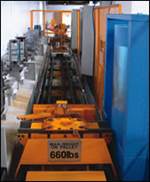Cellular Manufacturing Creates Most Efficient Processes
Living in a high-tech world, the first thing that comes to mind when you hear “cellular” might be a cell phone.
Share
Living in a high-tech world, the first thing that comes to mind when you hear “cellular” might be a cell phone. Not true when used with the word “manufacturing,” though. Cellular manufacturing refers to cells that are groupings of all the resources (people, supplies, machines, tools and equipment) required to manufacture a part or product. They are arranged for one-piece continuous flow—blank part goes in, finished piece comes out. The cell resources are arranged close together to enhance communication and allow visibility throughout the cell. A manufacturing cell has the capacity to achieve the appropriate takt time (the pace of production that matches customer demand) and meet all quality specifications.
Manufacturing cells allow manufacturers to produce just what is needed with minimum materials, equipment, labor, time and space, which translates to lower operating costs. A cell also has simple and direct routing between operations, so bottlenecks can easily be identified and eliminated, reducing leadtimes.
Continuous flow and takt time dictate cell design. Answering questions such as, “What processes have to be provided to complete the part within the equipment grouping?” and “How much of each process is needed to turn out parts fast enough to deliver orders on time?” will tell a shop whether or not they need an automated machine cell or a single, manually loaded VMC with some workstations.
The bottom line: Cellular manufacturing takes out most activities that do not add value to the part while speeding up the activities that do.
One company, Roberts Tool, had a cell up and running in 8 weeks. The cell takes up only 240 square feet, and the operator travels only 10 feet in each part cycle. A system of signals tells the operator what part to make next and when cell supplies need to be replenished. Read more about what was accomplished in this cell and how it was done in Cells to the Max.
Another resource, Cellular Manufacturing Can Help You, describes cellular manufacturing and its benefits in more detail and how to get started planning a cell.













.png;maxWidth=300;quality=90)

